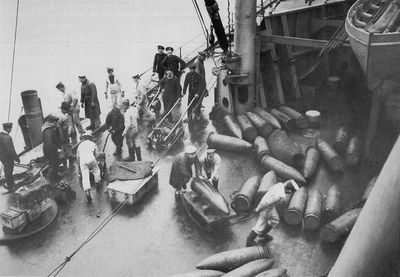Difference between revisions of "H.M.S. Lion (1910)"
Simon Harley (talk | contribs) (Made Changes.) |
m |
||
| Line 35: | Line 35: | ||
==Career== | ==Career== | ||
| − | [[File:Lion Ammunitioning, National Archives of Canada PA-6591.jpg|thumb|right| | + | [[File:Lion Ammunitioning, National Archives of Canada PA-6591.jpg|thumb|right|400px|''Lion'' taking aboard 13.5-inch shells.<br><small>Photo: Library and Archives Canada PA-6591''.</small>]] |
Late war Gunnery Officer [[William Bayard Hynes]] | Late war Gunnery Officer [[William Bayard Hynes]] | ||
| Line 58: | Line 58: | ||
==Bibliography== | ==Bibliography== | ||
| − | + | {{refbegin}} | |
*{{BibDittmarColledge}} | *{{BibDittmarColledge}} | ||
*{{BibUKFireControlInHMShips1919}} | *{{BibUKFireControlInHMShips1919}} | ||
| Line 65: | Line 65: | ||
*{{BibUKDreyerTableHandbook1918}} | *{{BibUKDreyerTableHandbook1918}} | ||
*{{BibSumidaIDNS}} | *{{BibSumidaIDNS}} | ||
| − | + | {{refend}} | |
[[Category:Ship]] | [[Category:Ship]] | ||
{{Lion Class (1910)}} | {{Lion Class (1910)}} | ||
Revision as of 21:34, 27 January 2010
| H.M.S. Lion | |
| Career | Details |
|---|---|
| Pendant Number: | 67 (Apr 1918)[1] |
| Built By: | Devonport Royal Dockyard |
| Laid Down: | 29 November, 1909 |
| Launched: | 6 August, 1910 |
| Commissioned: | 4 June, 1912 |
| Sold: | 31 January, 1924 |
| Fate: | Scrapped |
Construction
Armament
Lion was equipped with the Vickers-designed[2] 13.5-inch gun and mounting. Her mountings were constructed by Armstrongs and fired the 1,250lb projectile, and were designated MkII. The gun firing circuits were powered by on-mounting dynamos driven by water-turbine Pelton wheels fed by the hydraulic main.[3]
Reconstruction
Lion was taken in hand by Devonport Dockyard on 12 February, 1912. At that time her acceptance trial was projected to take place on 11 March.[4] She commissioned at Devonport on 4 June as Flagship of Rear-Admiral Lewis Bayly.[5]
Career
Late war Gunnery Officer William Bayard Hynes
Jutland
Officer in charge of T/S at Jutland Sub-Lieutenant R.P. Selby
According to the notes of Lieutenant-Commander Gerald Fortescue Longhurst, Lion's "A", "B", and "X" turrets expended 314 rounds of 13.5-inch A.P.C. Lyddite shell. "A" turret expended 95, "B" 107, "X" 112, and "Q" turret 12 before loss. At 20:38 "A" turret had 56 rounds per gun remaining, "B" 50, and "X" 50.[6]
Alterations
In 1913, Lion was slated as part of the seventeen ship order to receive a director. It was fitted sometime after the war started but prior to May, 1915.[7]
In May, 1917, in recognition of shortcomings in the use of directing guns, it was ordered that Lion and Princess Royal should be fitted with a second tripod-type director aft, as described on the class page. Lion received her second director during a refit in September, 1918.[8]
Fate
See Also
Footnotes
- ↑ Dittmar; Colledge. British Warships 1914–1919
- ↑ Roberts. Battlecruisers. p. 87.
- ↑ Roberts. Battlecruisers. p. 88.
- ↑ "The Battle Cruiser Lion" (News). The Times. Tuesday, 13 February, 1912. Issue 39820, col B, pg. 8.
- ↑ Roberts. Battlecruisers. p. 123.
- ↑ British Library. Jellicoe Papers. Add. MSS. 49029. f. 107.
- ↑ The Technical History and Index: Fire Control in HM Ships, pp. 9-10.
- ↑ The Technical History and Index: Fire Control in HM Ships, pp. 18-9.
Bibliography
- Dittmar, F.J.; Colledge, J.J. (1972). British Warships 1914–1919. London: Ian Allan.
- Template:BibUKFireControlInHMShips1919
- Template:BibBrooksDreadnoughtGunnery
- Template:BibUKDirectorFiringHandbook1917
- Template:BibUKDreyerTableHandbook1918
- Template:BibSumidaIDNS
